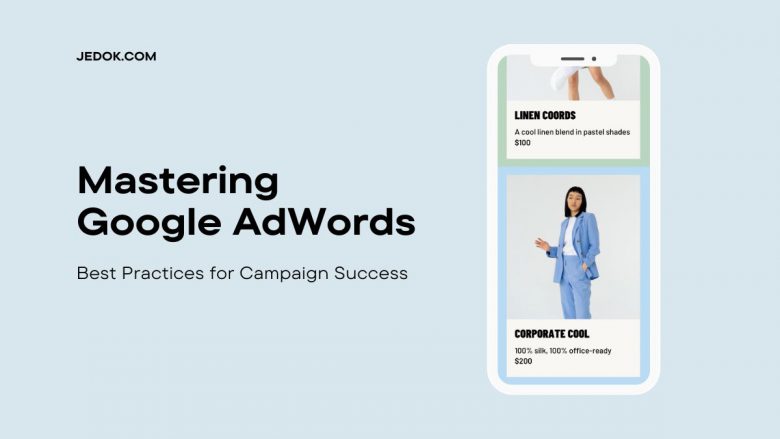
Google AdWords, now known as Google Ads, is a powerful advertising platform that can drive targeted traffic to your website and boost your business’s online visibility. However, running successful ad campaigns requires more than just setting up an account and creating ads. In this blog post, we will explore the best practices for mastering Google AdWords and achieving campaign success.
1. Understanding Your Audience:
Before jumping into the world of Google AdWords, it’s essential to have a solid understanding of your target audience. A buyer persona is a fictional representation of your ideal customer based on research and data. This persona helps you understand the needs, wants, pain points, and behavior patterns of your potential customers.
Defining your buyer persona is the first step toward creating a successful AdWords campaign. It enables you to tailor your ad copy, keywords, and landing pages to meet their specific needs and interests. By understanding what motivates them to make purchases or take action on your website, you can create targeted campaigns that resonate with them.
Google AdWords provides powerful targeting options that enable you to reach specific audiences based on factors such as demographics, location, interests, and search behavior.
2. Setting Clear Campaign Goals:
Setting clear campaign goals is crucial to the success of any advertising campaign, especially when it comes to Google AdWords. A well-defined set of objectives can help you track your progress and determine if your ads are making an impact on your target audience. Without clear goals, it’s impossible to know what you’re working towards or how to optimize your campaigns for maximum effectiveness.
When establishing your campaign goals, it’s important to make them specific, measurable, and achievable. This means that you should avoid vague objectives like “increase brand awareness” and instead focus on more concrete metrics such as clicks, conversions or return on investment (ROI). By setting specific targets for each metric, you’ll be able to measure the success of your campaigns more accurately and identify areas for improvement.
Once you’ve established your campaign goals, it’s also essential to track them regularly.
3. Conducting Keyword Research:
Conducting keyword research is a crucial step in creating successful Google AdWords campaigns. It’s the foundation of any well-planned and targeted ad campaign, as it helps you identify the right keywords to target your audience effectively. Keyword research allows you to understand what your potential customers are searching for on Google, what language they use to describe their needs, and how frequently they search for those terms.
One of the best tools available for conducting keyword research is Google Keyword Planner. It’s a free tool that provides valuable insights into search volumes and competition levels around specific keywords or phrases related to your business. With this information at your disposal, you can make informed decisions about which keywords will best align with your marketing goals and budget.
In addition to using tools like Google Keyword Planner, there are several other key factors to consider when conducting keyword research for Google AdWords campaigns.
4. Creating Compelling Ad Copies:
Crafting compelling ad copies is crucial for attracting clicks and driving conversions. A well-written ad copy can make the difference between a successful campaign and a failed one. With Google AdWords, you have an opportunity to showcase your products or services to potential customers. However, with so many ads competing for attention, your ad must stand out from the rest.
To create a compelling ad copy, start by identifying your target audience and their needs. Your message should resonate with what they are searching for and offer a solution to their problem. Use strong headlines that grab attention and highlight your unique selling proposition (USP). The body of the ad should expand on the headline and provide more information about why your product or service is the best option available.
Make sure that your ad copy includes relevant keywords to increase its visibility in search results.
5. Optimizing Landing Pages:
The success of your Google AdWords campaign doesn’t solely depend on the quality of your ad copies but also relies heavily on the quality of your landing pages. Your landing page is where your visitors are taken after clicking on your ad, and it needs to be optimized to provide an engaging experience that aligns with their search intent. Failure to optimize your landing page can result in low conversion rates, high bounce rates, and a waste of advertising budget.
To optimize your landing pages for maximum conversions, you need to ensure that they have a clear and concise message that aligns with the keywords you’re targeting in your ad campaigns. This means using headlines that match what users are searching for and incorporating keyword-rich content throughout the page.
6. Implementing Conversion Tracking:
Conversion tracking is a crucial tool for businesses that rely on online advertising to drive sales or generate leads. With conversion tracking, you can measure the effectiveness of your ads by tracking how many people take action after clicking on your ad. This critical information allows you to identify areas for improvement and make data-driven decisions about which ad campaigns are working best.
Google AdWords offers conversion tracking as part of its suite of digital marketing tools. By implementing conversion tracking in AdWords, you gain access to robust reporting features that allow you to track conversions across different devices, geographic locations, and ad formats. The insights gained from this data can help you optimize your campaigns for better performance and ultimately achieve a higher return on investment (ROI).
Setting up conversion tracking in Google AdWords is relatively straightforward.
7. Monitoring and Analyzing Performance:
Monitoring and analyzing performance is essential for any Google AdWords campaign. It is important to regularly monitor your ad campaign’s performance and make necessary adjustments to ensure optimal results. Analyzing key metrics such as click-through rate (CTR), conversion rate, cost per click (CPC) and cost per acquisition (CPA) provides valuable insights into the effectiveness of your ad campaigns.
The click-through rate measures the percentage of users who clicked on an ad after viewing it. A high CTR indicates that your ads are relevant and engaging, while a low CTR indicates that there may be room for improvement in your targeting or messaging. Conversion rate measures the percentage of users who completed a desired action such as making a purchase or filling out a form after clicking on an ad. A high conversion rate indicates that your ads are effectively driving conversions, while a low conversion rate may indicate issues with website functionality or landing page design.
8. A/B Testing and Experimentation:
A/B testing is a powerful tool that marketers can use to optimize the effectiveness of their campaigns. By conducting tests on various elements such as ad copies, landing pages, and other key components of your Google AdWords campaigns, you can gain valuable insights into what works best for your target audience.
One of the biggest benefits of A/B testing is that it allows you to identify which changes are actually making a difference in your campaigns. By comparing two different versions of an ad or landing page side-by-side, you can see exactly how each variation impacts user behavior and conversion rates. This data can then be used to make more informed decisions about which elements to prioritize moving forward.
To get the most out of A/B testing, it’s important to approach it with a scientific mindset.
9. Regular Budget Optimization:
Google AdWords is an essential tool for businesses looking to improve their online visibility and drive traffic to their website. However, simply setting up a campaign isn’t enough – regular budget optimization is crucial for maximizing the return on investment of your AdWords campaigns. By analyzing the performance of your campaigns regularly, you can identify areas for improvement and adjust your budget accordingly.
One key area to focus on when optimizing your AdWords budget is keyword performance. By identifying which keywords are driving the most traffic and conversions, you can allocate more of your budget toward those high-performing keywords while reducing spend on underperforming terms. Additionally, regularly reviewing ad copy and landing pages can help improve overall campaign performance by increasing click-through rates and improving user engagement.
Another important aspect of budget optimization is tracking conversion metrics such as cost per acquisition (CPA) or return on ad spend (ROAS).
10. Staying Updated with AdWords Updates and Best Practices:
Google AdWords is an ever-evolving platform that requires constant attention and adaptation. As the world’s most popular advertising platform, it helps businesses of all sizes to reach their audience in a targeted and effective way. However, keeping up with the latest updates and best practices can be a daunting task for even the most experienced marketers.
To stay ahead of the curve, it’s essential to stay informed about AdWords changes. Google regularly releases new features and updates to improve ad performance or provide more data insights. It’s crucial to keep an eye on these changes and adjust your campaigns accordingly if you want to get the most out of your ads.
Moreover, staying updated with AdWord’s best practices can help you optimize your campaign for maximum ROI. These best practices include creating targeted ads, writing compelling ad copy, using negative keywords effectively, and optimizing landing pages for conversion rates, among others.


